
Bluetooth is a short-range wireless technology standard that is used for exchanging data between fixed and mobile devices over short distances and building personal area networks (PANs). In the most widely used mode, transmission power is limited to 2.5 milliwatts, giving it a very short range of up to 10 metres (33 ft). It employs UHF radio waves in the ISM bands, from 2.402 GHz to 2.48 GHz. It is mainly used as an alternative to wired connections to exchange files between nearby portable devices and connect cell phones and music players with wireless headphones.

The Bluetooth Special Interest Group is the standards organization that oversees the development of Bluetooth standards and the licensing of the Bluetooth technologies and trademarks to manufacturers. The SIG is a not-for-profit, non-stock corporation founded in September 1998. The SIG is headquartered in Kirkland, Washington, US.

In the context of an operating system, a device driver is a computer program that operates or controls a particular type of device that is attached to a computer or automaton. A driver provides a software interface to hardware devices, enabling operating systems and other computer programs to access hardware functions without needing to know precise details about the hardware being used.
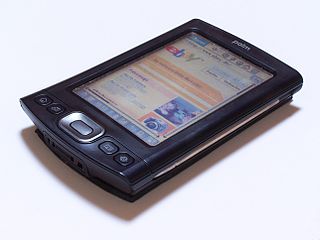
A personal digital assistant (PDA) is a multi-purpose mobile device which functions as a personal information manager. Following a boom in the 1990s and 2000s, PDA's were mostly displaced by the widespread adoption of more highly capable smartphones, in particular those based on iOS and Android in the late 2000's, and thus saw a rapid decline.
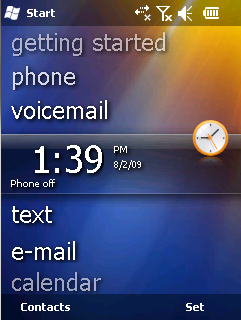
Windows Mobile is a discontinued mobile operating system developed by Microsoft for smartphones and personal digital assistants (PDA). Designed to be the portable equivalent of the Windows desktop OS in the emerging mobile/portable area, the operating system is built on top of Windows CE and was originally released as Pocket PC 2000.

Device Manager is a component of the Microsoft Windows operating system. It allows users to view and control the hardware attached to the computer. When a piece of hardware is not working, the offending hardware is highlighted for the user to deal with. The list of hardware can be sorted by various criteria.
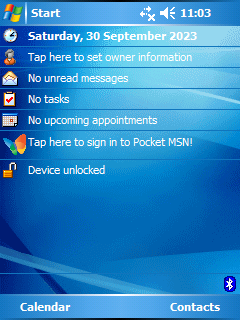
Windows Mobile 5.0 is a mobile operating system developed by Microsoft. It was originally codenamed "Magneto". It was released at Microsoft's Mobile and Embedded Developers Conference 2005 in Las Vegas, May 9–12, 2005. Microsoft offered mainstream support for Windows Mobile 5 through October 12, 2010, and extended support through October 13, 2015. It was first offered on the Dell Axim x51.
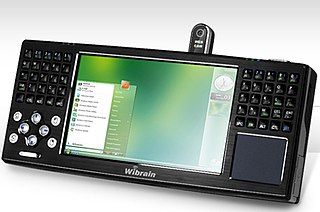
An ultra-mobile PC, or ultra-mobile personal computer (UMPC), is a miniature version of a pen computer, a class of laptop whose specifications were launched by Microsoft and Intel in Spring 2006. Sony had already made a first attempt in this direction in 2004 with its Vaio U series, which was only sold in Asia. UMPCs are generally smaller than subnotebooks, have a TFT display measuring (diagonally) about 12.7 to 17.8 centimetres, are operated like tablet PCs using a touchscreen or a stylus, and can also have a physical keyboard. There is no clear boundary between subnotebooks and ultra-mobile PCs, but UMPCs commonly have major features not found in the common clamshell laptop design, such as small keys on either side of the screen, or a slide-out keyboard.

Nokia PC Suite is a discontinued software package used to establish an interface between Nokia mobile devices and computers that run the Microsoft Windows operating system. Its first release was in 1997, originally called Nokia Data Suite. It was replaced by Nokia Suite and integrated into the Ovi service suite.

The Motorola Q is a Windows Mobile smartphone designed and manufactured by Motorola. It was first announced in the summer of 2005 as a thin device with a similar design to the Motorola Razr. The Motorola Q was first released in the United States on May 31, 2006, initially on the Verizon Wireless network, followed by Sprint in early January 2007 and Amp'd Mobile in April 2007.
A Bluetooth stack is software that is an implementation of the Bluetooth protocol stack.
In computing, Microsoft's Windows Vista and Windows Server 2008 introduced in 2007/2008 a new networking stack named Next Generation TCP/IP stack, to improve on the previous stack in several ways. The stack includes native implementation of IPv6, as well as a complete overhaul of IPv4. The new TCP/IP stack uses a new method to store configuration settings that enables more dynamic control and does not require a computer restart after a change in settings. The new stack, implemented as a dual-stack model, depends on a strong host-model and features an infrastructure to enable more modular components that one can dynamically insert and remove.

Windows Mobile Device Center is a synchronization software program developed by Microsoft, and the successor to ActiveSync. It is designed to synchronize various content including music, video, contacts, calendar events, web browser favorites, and other files between Windows Mobile devices and the Microsoft Windows operating system.
Bluetooth Low Energy is a wireless personal area network technology designed and marketed by the Bluetooth Special Interest Group aimed at novel applications in the healthcare, fitness, beacons, security, and home entertainment industries. Compared to Classic Bluetooth, Bluetooth Low Energy is intended to provide considerably reduced power consumption and cost while maintaining a similar communication range.
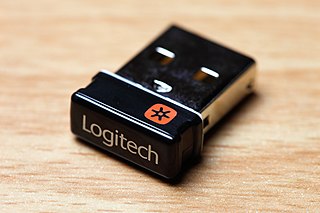
The Logitech Unifying Receiver is a small dedicated USB wireless receiver, based on the nRF24L-family of RF devices, that allows up to six compatible Logitech human interface devices to be linked to the same computer using 2.4 GHz band radio communication. Receivers that are bundled with a Logitech product are paired with the device at the factory. When purchasing a replacement receiver or connecting multiple devices to one receiver, pairing requires the free-of-charge Logitech Unifying software, available for Microsoft Windows and macOS. On Linux, the Solaar software can be used to adjust the configurations. Although not compatible with Bluetooth, devices pair to Unifying Receivers in a similar way. Peripherals remain paired, and can then be used on systems not supporting the software. Logitech receivers compatible with the Unifying protocol can be identified by the orange Unifying logo, which distinguishes them from Logitech Nano receivers of similar appearance, which pair similarly but only with a single device, without using the Unifying protocol.

The Xbox Wireless Controller is the primary game controller for the Xbox One and Xbox Series X/S home video game consoles, also the official controller for use in Windows-based PCs, and compatible with other operating systems such as macOS, Linux, iOS, and Android. The controller maintains the overall layout found in the Xbox 360 controller, but with various tweaks to its design, such as a revised shape, redesigned analog sticks, shoulder buttons, and triggers, along with new rumble motors within the triggers to allow for directional haptic feedback.

The Sound Blaster X7 is a USB audio device that can work without a computer. It was announced on 3 September 2014. It supports Microsoft Windows and Mac OS X computers but requires a power supply to work. The Sound Blaster X7 has the SB-Axx1 sound chip built-in. Android and iOS devices can change SBX Pro Studio audio settings with the Sound Blaster X7 Control app.

Phone Link, previously Your Phone, is a syncing software developed by Microsoft to connect Windows PCs to Android and iOS mobile devices to view notifications, make phone calls, use mobile apps amongst others, via the PC. It is a native component of Windows 10 and Windows 11, where it is a UWP app and consists of a driver that communicates with the Link to Windows app on the mobile device. Phone Link makes use of Wi-Fi, Bluetooth for voice calls, or mobile data.
The Google Fast Pair Service, or simply Fast Pair, is Google's proprietary standard for quickly pairing Bluetooth devices when they come in close proximity for the first time using Bluetooth Low Energy (BLE). It was announced in October 2017 and initially designed for connecting audio devices such as speakers, headphones and car kits with the Android operating system. In 2018, Google added support for ChromeOS devices, and in 2019, Google announced that Fast Pair connections could now be synced with other Android devices on the same Google Account, a feature which Google expanded to ChromeOS devices in December 2023. Google has partnered with Bluetooth SoC designers including Qualcomm, Airoha Technology, and BES Technic to add Fast Pair support to their SDKs. In May 2019, Qualcomm announced their Smart Headset Reference Design, Qualcomm QCC5100, QCC3024 and QCC3034 SoC series with support for Fast Pair and Google Assistant. In July 2019, Google announced True Wireless Features (TWF), Find My Device and enhanced Connected Device Details.

Nearby Share was a functionality developed by Google that allows data to be transferred between devices via Bluetooth, Wi-FI Direct or Internet. In 2024, it was merged into Samsung's Quick Share. It was available for Android, ChromeOS and Microsoft's Windows. It was first released on August 4, 2020.














